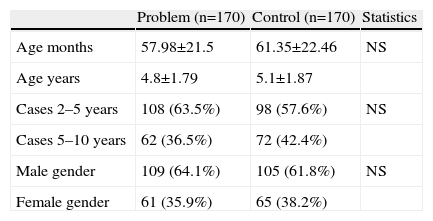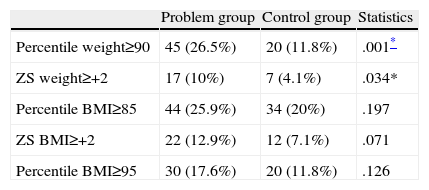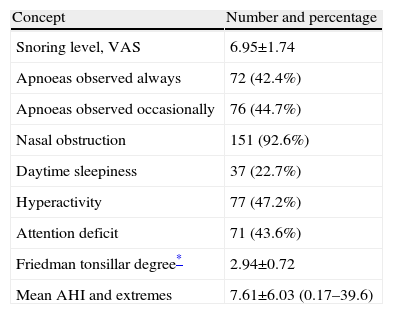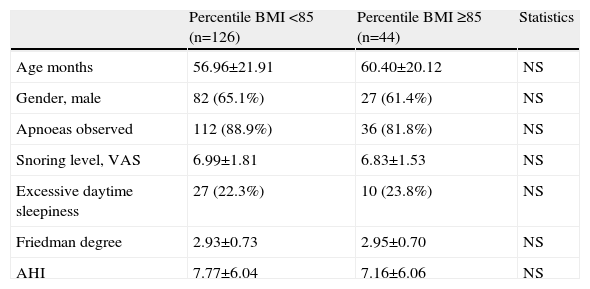The increasing prevalence of childhood obesity leads to an increase risk of sleep-disordered breathing and may exacerbate their comorbidities.
PurposeTo assess the rate of obesity in children with sleep-disordered breathing and to study the possible clinical and epidemiological differences between children with and without overweight in a private hospital in the Mediterranean area.
Materials and methodsWe prospectively studied 340 children between 2 and 10 years. There were 170 children with sleep-disordered breathing (study group) and 170 healthy children (control group). In the problem group, the apnea–hypopnea index was around 7.61±6.3.
ResultsThe comparison of the percentage of cases with a BMI percentile ≥85 (overweight) between problem and control groups (44: 25.9% vs 34%: 20%) or with a BMI ≥95 (obesity) (30: 17.6% vs 20%: 11.8%) showed no statistically significant differences. In addition, the comparison of clinical and epidemiological variables in the problem group, cases with (44/170: 25.9%) and without (126/170: 74.1%) overweight, did not show significant differences in any of the parameters analysed.
ConclusionIn the population studied, it does not appear that the group of children with sleep breathing disorders presents higher rates of obesity, nor does obesity influence its presentation clinically. These results had probably been influenced by the characteristics of the studied population and therefore should not be an obstacle for being attentive to the possible association of respiratory disease to obesity and its negative consequences.
La creciente prevalencia de obesidad infantil genera un incremento del riesgo de desarrollar trastornos respiratorios del sueño y puede agravar sus comorbilidades.
ObjetivoEstudio prospectivo para evaluar la tasa de obesidad en niños con trastornos respiratorios del sueño y estudiar las eventuales diferencias clínicas y epidemiológicas entre los niños con y sin exceso de peso en un hospital privado del área mediterránea.
MétodoSe estudian 170 niños entre dos y 10 años con trastorno respiratorio del sueño y un grupo control de 170 niños sanos. En el grupo problema el índice de apnea-hipoapnea medio es de 7,61±6,3.
ResultadosLa comparación del porcentaje de casos de percentil del índice de masa corporal (IMC)≥85 (sobrepeso) entre ambos grupos problema y control (44: 25,9% vs 34: 20%) o los de IMC≥95 (obesidad) (30: 17,6% vs 20: 11,8%) no muestra diferencias estadísticamente significativas. La comparación de las variables clínicas y epidemiológicas en el grupo problema entre los casos con sobrepeso (44/170: 25,9%) y sin sobrepeso (126/170: 74,1%), tampoco muestra diferencias en ninguno de los parámetros analizados.
ConclusiónEn el ámbito del estudio no se observa que los niños con trastornos respiratorios del sueño presenten mayor tasa de obesidad ni que ésta condicione clínicamente la forma de presentación. Es probable que el tipo de población de este estudio condicione estos resultados y por tanto no debe ser óbice para no estar atentos a la posible asociación de la afección respiratoria y obesidad por sus consecuencias negativas.









